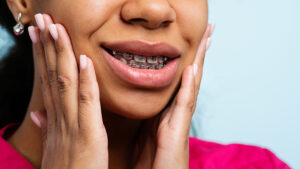When it comes to achieving a straighter smile, there are two main contenders in the orthodontic arena: Invisalign and traditional braces. Both offer effective solutions for correcting misaligned teeth, but they come with their own set of pros and cons. Discover more facts about the Invisalign vs braces debate, helping you determine which option is the best fit for your orthodontic needs.
Understanding Invisalign

Invisalign is a modern orthodontic treatment designed to straighten teeth discreetly. Unlike traditional braces, which use metal brackets and wires, Invisalign employs a series of clear, custom-made aligners. These aligners are made from a smooth, BPA-free plastic that fits snugly over your teeth, gradually shifting them into the desired position
Each set of Invisalign aligners is worn for about two weeks before being replaced with the next set in the series. The gradual progression of aligners applies gentle pressure to your teeth, encouraging them to move into alignment over time. Your orthodontist will determine when this process has produced the desired results.
Aligners are almost invisible.
One of the primary advantages of Invisalign is its discreet nature. The clear aligners are virtually invisible when worn, making them a popular choice among adults and teenagers who may feel self-conscious about wearing traditional braces. Invisalign allows you to straighten your teeth without drawing attention to your orthodontic treatment, allowing you to maintain confidence in your appearance throughout the process.
They are removable.
Invisalign aligners are removable, giving you the flexibility to eat, drink, brush, and floss as you normally would. This means you can continue to enjoy your favorite foods and maintain good oral hygiene without any special restrictions. However, it’s essential to wear your aligners for at least 20 to 22 hours per day to ensure optimal results.
Considerations
While Invisalign offers many benefits, it may not be suitable for everyone. It’s typically recommended for mild to moderate cases of misalignment, such as crowded teeth, gaps, or minor bite issues. Severe orthodontic problems may require traditional braces for more effective treatment.
Invisalign treatment requires discipline and commitment. Since the aligners are removable, it is up to you to follow your orthodontist’s instructions. Failure to wear your aligners consistently can prolong your treatment time and affect the final outcome.
Finally, the cost of Invisalign treatment may be higher than traditional braces, depending on your specific dental needs and insurance coverage. However, many patients find the benefits of Invisalign, such as comfort and aesthetics, to be well worth the investment.

Exploring Traditional Braces
Traditional braces have been a staple in orthodontic treatment for decades, providing a reliable method for correcting various dental issues. Braces consist of metal brackets that are bonded to the teeth and connected by wires and elastic bands. This system applies continuous pressure to the teeth, gradually moving them into proper alignment.
Effective Treatment
One of the significant advantages of traditional braces is their effectiveness, particularly for complex cases of misalignment or bite problems. Braces can address severe overcrowding, significant gaps, and more complicated orthodontic issues that may not be suitable for Invisalign treatment.
Considerations
Unlike Invisalign, which relies on removable aligners, traditional braces are fixed in place throughout the treatment process. While this means you don’t have to worry about remembering to wear your braces, it also comes with some drawbacks. The metal brackets and wires of traditional braces are visible when you smile, which can be a concern for some individuals, especially adults.
Wearing braces can cause discomfort, particularly during the initial adjustment period and after routine tightening appointments. As your teeth adjust to the pressure the braces are applying, you might experience soreness or irritation in your mouth. However, over-the-counter pain relievers and orthodontic wax can help alleviate discomfort during this time.
Another consideration with traditional braces is dietary restrictions. Certain foods, such as hard candies, sticky sweets, and crunchy snacks, can damage or dislodge the brackets and wires. Your orthodontist will provide you with a list of foods to avoid to prevent any complications during your treatment.
On the plus side, many dental insurance plans cover a portion of the cost of traditional braces, making them a more affordable option for some patients. However, it’s essential to check with your insurance provider to understand your coverage and any out-of-pocket expenses you may incur.

Invisalign vs Braces: Factors to Consider When Choosing
When deciding between Invisalign vs braces, several factors come into play. Understanding these factors can help you make an informed decision that aligns with your specific orthodontic needs, lifestyle, and preferences.
1. Severity of Misalignment
Consider the extent of your dental issues. Invisalign is typically recommended for mild to moderate cases of misalignment, such as crowded teeth, small gaps, or minor bite issues. On the other hand, traditional braces are more suitable for severe orthodontic problems, including significant overcrowding, large gaps, or complex bite issues. Your orthodontist will assess your condition and recommend the most appropriate treatment option based on the severity of your misalignment.
2. Lifestyle and Preferences
Evaluate your lifestyle and personal preferences. If you prioritize discretion and prefer a more aesthetically pleasing option, Invisalign may be the better choice. The clear aligners are virtually invisible when worn, allowing you to maintain confidence in your smile throughout the treatment process. However, if appearance is less of a concern and you prefer a treatment that requires minimal maintenance, traditional braces might be a better fit.
3. Budget and Insurance Coverage
Consider your budget and any insurance coverage you may have. Invisalign treatment tends to be more expensive than traditional braces, although the cost can vary depending on factors such as the complexity of your case and your location. Check with your orthodontist and insurance provider to understand the total cost of each treatment option and any coverage you may be eligible for.
Keep in mind that while dental insurance frequently covers traditional braces, coverage for Invisalign might be more limited or necessitate additional out-of-pocket costs.
4. Treatment Duration
Think about your timeline for achieving results. Invisalign treatment typically takes around 12 to 18 months for most cases, although the duration can vary depending on individual factors. Traditional braces may require a similar timeframe or longer, depending on the complexity of your orthodontic issues. Discuss your treatment goals and timeline with your orthodontist to get a better understanding of how long each option will take to achieve your desired results.
Transform Your Smile with Confidence
At Phillips Family Orthodontics, whatever you choose between Invisalign vs braces, we prioritize your experience above all else. Our dedication to your exceptional journey is evident in every aspect of our practice. With a focus on holistic care, we go beyond straightening teeth to ensure your overall well-being shines through.
Trust us for expert Invisalign treatment and state-of-the-art braces options tailored to your needs. Schedule your consultation today.

